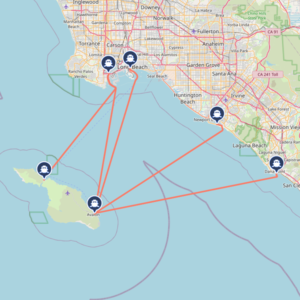The Essential Guide to Ferry Travel
Traveling by ferry is one of the oldest forms of travel. While the logistics have improved over the years, the essence of hopping on a ferry to be transported to your destination hasn’t changed in the past few centuries.
While airplanes and cars usually transport the bulk of vacationers these days, ferry travel comes with its own set of advantages you can’t find anywhere else.
Whether you’re considering taking a ferry on your next-day trip, weekend getaway, or summer holiday, this article will help you feel more prepared before you step on the boat. Read on to learn everything you need to know before you make it to the port and how to make the most of your trip once you’re on board.
How to Plan Your Ferry Trip
Fortunately, the process is much simpler now if you search with us. On FerryGoGo, you can search for routes based on the country you want to visit, the port you’re leaving from, or the ferry line you want to sail with. It’s a convenient way to find a ferry crossing that suits your travel plans.
You can for instance navigate by different maps on different pages / guides:
- All ferries in the UK. (a complete overview)
- All (direct) ferries from UK to France.
- Just the Dover-Calais Route.
How far in advance should you book a ferry?
Booking airline tickets well in advance is a prime way to cut travel costs when you’re planning a trip. The same is true when it comes to reserving ferry tickets. If you already know when you'll be traveling, aim to book your ferry ride three to six months in advance. This is usually when you’ll be able to get the best price on your passage fare.
If possible, the latest you should book your ferry is one month before you plan to travel. Once you get into the days or weeks before your trip, ticket demand usually increases. As a result, prices often increase, as well. This is especially true if you plan to visit a destination during its high tourism season, like the Greek islands during the summer.
However, if you have a last-minute trip coming up, you may still be able to snag a deal. To do this, though, you’ll probably need to wait until you’re at your destination to reserve your ferry crossing. Sometimes, smaller ferry operators will sell discounted tickets for next-day or day-of passages so they can still turn a profit.
There’s no guarantee, but it’s worth visiting your ferry line’s main office to ask in person for any last-minute deals they might have.
India Amos Tweet
Can I bring my car on the ferry?
If you’re going on a long holiday, having your own vehicle could add a level of convenience and comfort to your stay in an unfamiliar destination. Some ferries allow you to drive your car onto the boat so it can be safely transported to your destination. If you need your vehicle for your trip, this can be an efficient way to make sure it gets there safely.
Regardless, remember that bringing your car onto a ferry doesn’t come without a cost. In fact, it can add significant charges to your passage fare. If you plan on spending a few weeks or months at your destination, bringing your car on the ferry could be cheaper than renting a car in the city or town where you’ll be staying.
Before you decide whether to take your car on your trip with you, make sure you find out if it’s possible on your ferry and whether it’s a good financial decision to do so.
How do I prepare for a ferry trip?
Now that you’ve booked your ticket, it’s time to get ready for your ferry trip. If this is your first time riding a ferry, there are some basic steps you can take to make sure your voyage is as comfortable as possible.
1. Figure out the type of ferry you’ll be on.
Not all ferries are created alike. Bigger vessels are usually ideal for first-time ferry tourists because they absorb more of the motion you would otherwise feel from the waves. Conversely, you’ll probably feel every ebb and flow of the water if you’re on a smaller vessel.
There are many ways you can avoid seasickness on a ferry. However, you can reduce your chances of having a rocky ride by booking passage on a larger boat.
2. Decide if you want to reserve your seat in advance.
Depending on your ferry route and line, you might have the option of reserving a specific seat on the vessel. Some ferries require you to select a seat assignment when you book your ticket. Other ferries only require it if you choose to purchase a premium or higher-status ticket. In other situations, ferries don’t offer seat selection at all.
When the option to select a seat assignment is available to you, you may want to take advantage. There are pros and cons to both options.
On one hand, choosing to forego seat selection can usually save you money. Plus, if you have a ticket on the ferry, you’re guaranteed to get on the boat and travel to your destination. However, you run the risk of having to sit in a noisy part of the ferry. If you’re traveling with friends or family members and aren’t one of the first people on board, there's also a good chance you won't be able to sit with your party.
On the other hand, selecting your seat assignment in advance can give you peace of mind on your travel day. It usually costs more, but it might be worth it if you loathe feeling rushed or prefer a specific seat on the vessel. For example, if you absolutely want a window seat for your ferry crossing, consider reserving it in advance.
3. Make sure you have the necessary documents.
The types of identification you’ll need to bring on the ferry with you depends on where you’re coming from and where you’re going. If you’re going from Boston to Salem, Massachusetts, for example, you’ll only need to bring your driver’s license or government ID because you’re staying within the United States.
However, if you want to sail across the Strait of Gibraltar and go from Spain to Morocco, you’ll need to provide a valid ID. (In 99% of the cases a passport).
Check with your ferry line to determine the specific documentation you’ll need for your voyage. Depending on your trip, you might need:
- A visa.
- Proof of vaccination.
- Customs declaration form.
- Printed travel confirmation.
Make sure to check out our article about the ultimate ferry packing list as well:
What to Wear on a Ferry
As you get closer to your ferry departure date, it’s important that you consider what you’ll wear on the passage. Many ferries are equipped with AC and heaters so your voyage is comfortable no matter ‘when' you go.
However, hiccups can occur. To make sure your trip is enjoyable, there are certain items you should wear on the ferry. In general, you should wear:
- Closed-toed shoes with socks. This is especially true for longer voyages. You never know if the ship will be cold, so dress accordingly.
- Layered shirts and jackets. Temperatures might change on the boat, so you need to be prepared. Dressing in layers will help you be ready for whatever temperature you encounter.
- Comfortable pants. When you’re on the ferry, you’ll need to do some walking or standing before you board and then a lot of sitting. Dress so you feel cozy.
What can I bring on a ferry?
As you prepare for your upcoming ferry trip, you’re probably wondering how much luggage you can bring with you and what you can pack in your suitcase. If you’re only used to traveling by airplane, you might be surprised how much more relaxed baggage rules for sea travel can be.
Generally, ferry luggage size requirements and bag limits vary by the line and voyage type. For longer international trips, you’ll probably be allowed more baggage than if you were going on a local day trip.
It’s not uncommon for some ferries to allow you to bring an unlimited amount of baggage. However, other lines cap you at one carry-on and two large suitcases. Some might allow you to store it in the boat like a checked bag in an airplane, while others might require you to always keep your luggage with you.
Avoid confusion on your departure date by confirming this information before you arrive at the port.
Next, be aware of the types of items you pack in your luggage. Unlike with air travel, you can bring liquids on the ferry with you. Additionally, specific rules regarding the types of weapons or sharp objects you can bring on the ferry vary by country and ferry line. Make sure you check your destination’s government website to determine what you can legally transport into the country.
How do I board a ferry?
Now that you’ve made your preparations, it’s time to finally get on the ferry.
Boarding for an International Ferry Trip
For international passages, the boarding procedure is similar to what you’d experience at the airport. Because of this, plan to arrive at the port at least two hours before your boat is set to sail. There might be unexpected changes to your check-in procedure, so make sure you have enough time to pivot before you board.
You’ll then pass through a check-in counter. Here, you’ll need to show your ticket and identification. If your ferry line allows you to store your luggage under the boat, you might be able to drop it off here.
Next, you will pass through security. Usually, you’ll need to put your belongings through an X-ray machine. Then, you will need to walk through a metal detector. Unlike at the airport, they probably won’t ask you to remove your shoes.
Afterward, you will go through immigration. This is where you will show your passport and answer the officer’s questions about your trip. Once you complete this step, you should be able to wait in the port lounge until your boarding number is called.
Boarding for a Domestic Ferry Trip

A picture I made from actually boarding my ferry in Greece © FerryGoGo
Since you are traveling in the same country, your arrival process should be shorter. If you’re going on a day trip, you’ll probably only need to go to a check-in counter. There, you’ll show your boarding ticket and identification. Then, they’ll either let you board immediately or wait until it’s your time to get on the boat.
Make sure you’re on time for your trip. Otherwise, you might get left behind. This could result in your ticket being canceled or the ferry line rebooking you on a later passage.
Tips for Traveling on a Ferry
Now that you know what to expect for your ferry voyage, here are some additional tips for traveling on a ferry to make your experience even more pleasant.
- Save money by bringing drinks and snacks with you on board. Most ferries sell food and beverages on board. However, they’re almost guaranteed to be overpriced. By bringing your own snacks with you, you can eliminate this unnecessary charge on your trip.
- Keep your valuables with you at all times. This goes for secure documents like your ID or passport, wallet, or phone. Keep them in your purse or in your pocket, and carry them with you wherever you go.
- Don’t abandon your bags. It can be tempting to leave your bags near your seat and go out on deck to see the water. Don’t. No matter where you go on the boat, make sure you take your carry-on items with you.
- Be proactive about
- A picture I made from actually boarding our ferry in Greece
- seasickness. Feeling nauseous your whole ferry ride is miserable. Make sure you bring medication or supplements to help with motion sickness before you board the ferry.
If you have any other helpful tips or questions, let me know in the comments!












Thanks Ferry Go Go, this article highlights the timeless appeal of ferry travel and offers valuable insights on how to plan a ferry trip. We are a family of 5 and are planning a trip next summer, so this has been very helpful.
Hi Peter,
Good to know! If you have any other questions let me know!
~ Jochem